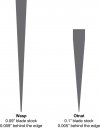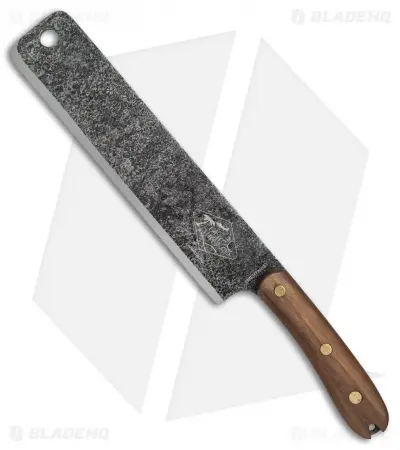Hi,
I am curious to hear what you think about the effects of blade height (just to be clear I am talking about the distance between the cutting edge and the spine) and what the purpose would be of a knife with more blade height than another.
The reason I ask is because I recently got turned onto Bark River knives and bought both a Gunny and a Bravo 1LT. I figure I probably don't need them both so will probably sell one and I am trying to figure out which to keep since I like them both.
But when I started to compare them closely that although the Bravo 1LT looks much bigger (handle size aside which is purely a matter of personal preference) I see that the blade thickness is not that much different on the two (the Bravo 1LT is a slight bit thicker) and that the blades are pretty close to the same length (3.85 I believe vs. 4.25). The biggest difference is the blade height or width. The Bravo 1 is significantly higher / wider, but the cutting edges are not that much different in length or shape.
So why the super wide blade on the Bravo 1 and what would be the advantages and disadvantages, given that the cutting edge and thickness are fairly similar? Why do some knives have super wide / high blades like skinning knives do?
My guesses are the following: I assume that the Bravo 1LT has a wide blade since it was derived from the Bravo 1 which is quite thick at about .25 inches. I assume that the super wide blade allowed for a more gradual taper down to a fine edge to make it a better cutter. I also assume the wider blade meant more steel and therefore strength. My suspiscion is that this width/height is not really as necessary on the LT version.
My assumption that between the Gunny and the Bravo 1LT that the greater width of the Bravo would probably be a bit better splitter for battoning and a bit stronger/stiffer. On the other hand it would seem that the wider blade moves the cutting edge farther away from the centerline of the hand and therefore reduces some leverage for shear cuts.
What other advantages / disadvantages would you see between the higher / wider blade of the Bravo LT vs the Gunny?
I have used both them a little but not much so I have some limited observations, but am interested in the design theory in general.
thanks and sorry for the long and geeky post.
Matt
I am curious to hear what you think about the effects of blade height (just to be clear I am talking about the distance between the cutting edge and the spine) and what the purpose would be of a knife with more blade height than another.
The reason I ask is because I recently got turned onto Bark River knives and bought both a Gunny and a Bravo 1LT. I figure I probably don't need them both so will probably sell one and I am trying to figure out which to keep since I like them both.
But when I started to compare them closely that although the Bravo 1LT looks much bigger (handle size aside which is purely a matter of personal preference) I see that the blade thickness is not that much different on the two (the Bravo 1LT is a slight bit thicker) and that the blades are pretty close to the same length (3.85 I believe vs. 4.25). The biggest difference is the blade height or width. The Bravo 1 is significantly higher / wider, but the cutting edges are not that much different in length or shape.
So why the super wide blade on the Bravo 1 and what would be the advantages and disadvantages, given that the cutting edge and thickness are fairly similar? Why do some knives have super wide / high blades like skinning knives do?
My guesses are the following: I assume that the Bravo 1LT has a wide blade since it was derived from the Bravo 1 which is quite thick at about .25 inches. I assume that the super wide blade allowed for a more gradual taper down to a fine edge to make it a better cutter. I also assume the wider blade meant more steel and therefore strength. My suspiscion is that this width/height is not really as necessary on the LT version.
My assumption that between the Gunny and the Bravo 1LT that the greater width of the Bravo would probably be a bit better splitter for battoning and a bit stronger/stiffer. On the other hand it would seem that the wider blade moves the cutting edge farther away from the centerline of the hand and therefore reduces some leverage for shear cuts.
What other advantages / disadvantages would you see between the higher / wider blade of the Bravo LT vs the Gunny?
I have used both them a little but not much so I have some limited observations, but am interested in the design theory in general.
thanks and sorry for the long and geeky post.
Matt





